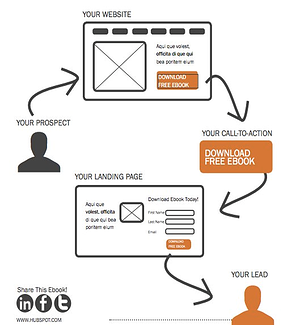 Does your technology company use blogging to generate leads and promote your brand to your ideal customers? If not, you're at a competitive disadvantage. SMB marketing automation software provider HubSpot found that companies that blog 15 or more times a month get 5 times more web traffic than companies that don't blog. If you use blogging best practices, you can generate qualified leads from your website and position your company as a thought leader within your industry. You've likely come to the conclusion that blogging is a good idea for your company, but you may not be sure how to blog effectively to achieve your goals. Here are 6 tips for managing your technology company blog.
Does your technology company use blogging to generate leads and promote your brand to your ideal customers? If not, you're at a competitive disadvantage. SMB marketing automation software provider HubSpot found that companies that blog 15 or more times a month get 5 times more web traffic than companies that don't blog. If you use blogging best practices, you can generate qualified leads from your website and position your company as a thought leader within your industry. You've likely come to the conclusion that blogging is a good idea for your company, but you may not be sure how to blog effectively to achieve your goals. Here are 6 tips for managing your technology company blog.
1. Define Your Ideal Customer Profile To Focus Your Blog Content
The first step in managing a blog to achieve your goals of generating qualified leads and promoting your brand is to define your ideal customer profile. Your ideal customer profile defines the type(s) of companies that are most likely to become profitable customers. The ideal customer profile could be defined by:
- Vertical industry markets (for example, software companies)
- Company size (for example, revenue between $1 and $50 million or headcount between 25 and 200 employees)
- Internal criteria (for example, companies that don't have an internal inbound marketing team)
- Challenges faced (for example, companies facing growth challenges.)
Here is a sample ideal customer profile: software companies with revenues between $1 and $50 million that don't have an internal inbound marketing team that need to grow by 10% or more.
You also need to define "buyer personas" for your buyers at your ideal customers. Buyer personas are composite representations of the individuals that buy from you. Your buyer personas may include:
- Demographic data for your targeted personas (gender, age group, family status, etc.)
- Common business challenges that they face
- Their goals and aspirations
Once you've defined your ideal customer profiles and buyer personas, you should focus your blog articlers on helping your ideal customers and buyer personas.
2. Define The Keyword Phrases Your Ideal Customers Use To Research The Problems Your Company Solves On Google
Now that you've defined your ideal customer(s), you need to create a list of keyword phrases that they use to research the problems your company solves on the web. Here are some tips to develop your preliminary list:
- Ask your customers which 3-5 word phrases they would use to search for your products and services on Google.
- Ask your employees which 3-5 word phrases they would use to search for you on Google.
- Use tools like HubSpot or the Google AdWords Keywords Tool to get suggestions
When targeting keywords, focus on "long-tail keywords" (keywords that contain more than 4 words). These long-tail keywords are easier to rank for and will generate more qualified web traffic. Rather than software, target phrases like business intelligence software for insurance agencies. As you develop your keyword list, look for phrases that get a reasonable amount of monthly traffic, but are not too difficult to rank for.
Use your targeted keywords in your blog titles and within the articles. Don't overdo it! Make sure your writing is targeted to your readers, not search engines. A good rule of thumb is to target 1 or 2 keyword phrases per article and use the phrase no more frequently than once per paragraph. You can use the keyword phrase more frequently if it reads naturally and contributes to a good user experience.
3. Create An Editorial Calendar And Stick To It
The impact of blogging on web traffic is pretty straightforward: the more you blog, the more traffic you will get. I recommend starting with a blogging frequency you can maintain and committing to it. You're better of deciding to blog weekly and sticking with it than starting off with 3 blog posts per week and quitting after a month. It takes time to reap the rewards of your efforts, so pick a frequency you can maintain. You can always increase your frequency as you get more comfortable with managing your blog.
So what should you write about? Simple - you should answer the questions your ideal customer has about the problems you solve. A good place to start would be to ask your customer service and sales people what common questions they hear from your customers. You can also see what kind of questions your audience are asking on social media networks. LinkedIn Groups are a good place to start.
Once you've come up with your topics, find ways to incorporate your targeted keyword phrases in the titles and schedule out 3 months worth of blog articles on an editorial calendar. It's much easier to keep your blogging momentum going when you have topics scheduled out in advance.
4. Make Sure You Include Inbound Lead Generation Opportunities In Your Blog Posts
The process for generating leads in your blog posts is to offer a premium content offer like an eBook in exchange for contact information (typically name and e-mail address for the initial download.) Here is a graphical representation of the process courtesy of HubSpot:

Make sure to include an appropriate lead generation offer with each blog post. If you want to generate leads with your blog, you must do this.
5. Use Social Media To Promote Your Blog Content
Now that you're regularly publishing blog articles targeted to your ideal customers, your next step is to use social media to promote your blog articles. Find the social media networks that your buyers frequent and post your new blog articles there. For most SMB companies, LinkedIn, Facebook, Google+ and Twitter are good networks to consider. You're better off doing one network really well than being mediocre on several networks.
Publish your blog articles and lead generation landing pages along with useful content created by others. A good rule of thumb is to use the 10:4:1 rule: for every 15 social media posts, 10 should be relevant content created by others, 4 should be your blog posts and 1 should be for your lead generation landing page. If all you post is your own blog articles and landing pages, you come across as self-promoting and not particularly helpful.
You should also make it easy for your readers to share your blog content. Use social sharing buttons so that your readers can easily share your blog articles with their social networks. This is important for SEO because social shares are becoming increasingly important in Google's ranking algorithm.
6. Use Analytics To Improve Your Blogging
Most marketing automation software like HubSpot provides analytics on your blogging efforts. You should analyze your data to:
- see which blog articles are getting the most pageviews. Analyze this data to identify trends in your most popular articles that you can use to focus your future efforts.
- see which blog articles generate the most leads. Look at the topics that are generating leads to see what is interesting to your audience.
- see which social media channels generate the most pageviews and leads. This will help you zero in on which social channels your target audience inhabits.
Summary
Blogging is an integral part of a coordinated inbound marketing program. When managed properly, your blog can be a source of qualified web traffic and leads. When you create high-quality blog articles, you promote your company as a thought leader within your industry.
Follow these blogging best practices and you will see results. Do you need help managing your blog? Contact us for a free consultation.










